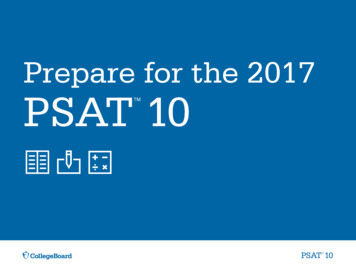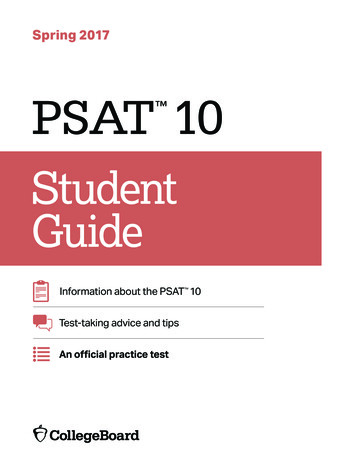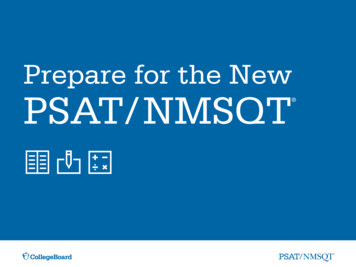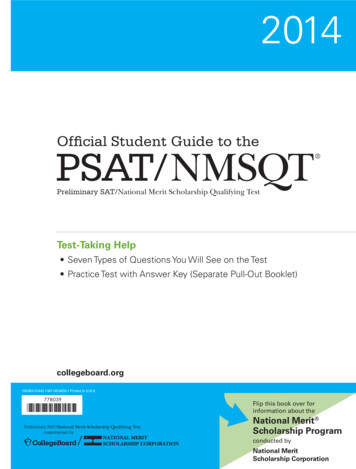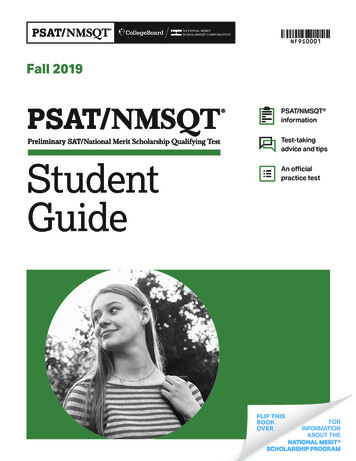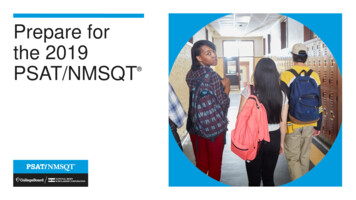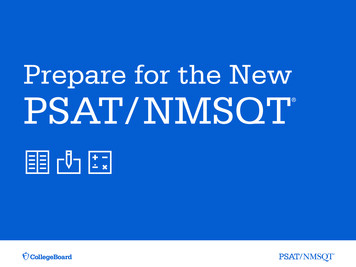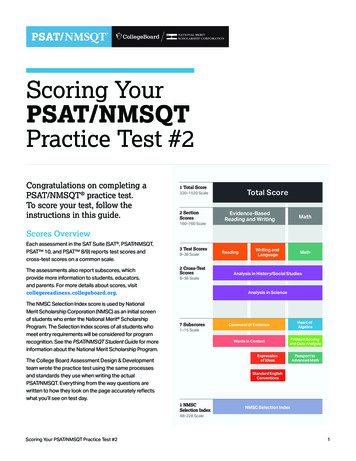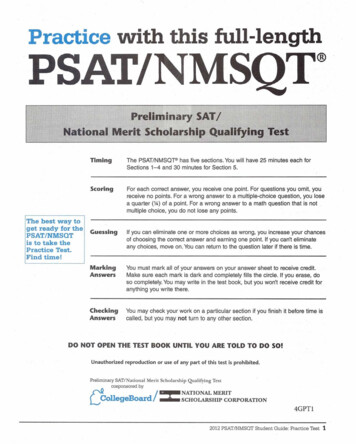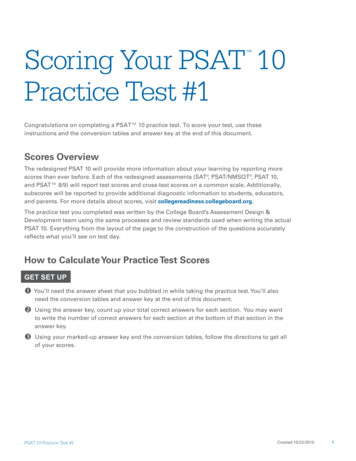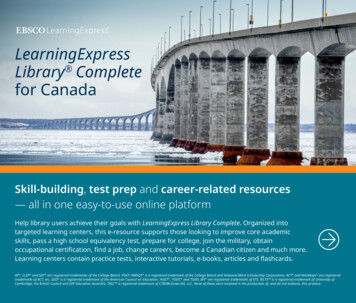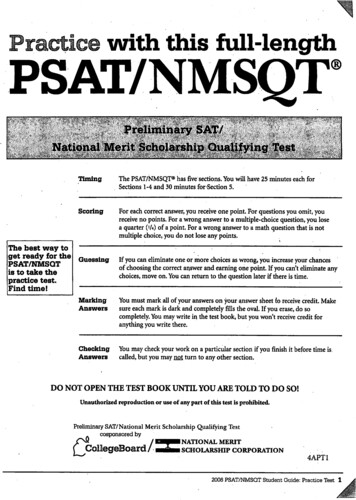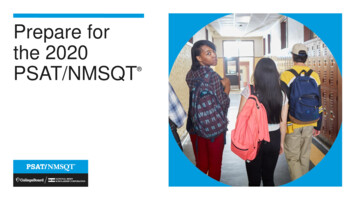
Transcription
Prepare forthe 2020PSAT/NMSQT
What Is thePSAT/NMSQT?
SomeKey FactsThe PSAT/NMSQT assesses the same knowledgeand skills as the SAT, providing a check-in oncollege readiness before students take the SAT .Scores are reported on a common vertical scale,allowing educators and students to measureprogress Propels students toward college and careerreadiness Is cosponsored by the College Board andNational Merit Scholarship Corporation3.8 millionstudents take the PSAT/NMSQT eachyear to get feedback on their skillsand practice for the SAT. Serves as an entry point to over 300 million inscholarship dollars3
What to knowabout thePSAT/NMSQTNo points deducted for incorrect answers orunanswered questions, also known as“rights-only scoring”Scale ranges for the scores are320 – 1520 for the total score4
Benefits of thePSAT/NMSQTPersonalized SAT practice on Khan Academybased on students’ PSAT/NMSQT answersAligned to the SATIncreased access to additionalscholarship providersOnline college and career planning toolsAdmission and financial aid informationfrom collegesMajors and career exploration withCollege Board and Roadtrip Nation5
PSAT/NMSQT 2019Test Dates & TimesPrimaryTest DateOCT14Start Time: 7:45 amEnd Time: 12:00 pm*Students receiving Extended Time Accommodations will end by 1:00 pm. Seeletter from Ms. Rezabek sent October 2nd6
Skills Testedon thePSAT/NMSQT
Skills TestedReading TestWriting and Language TestMath Test Each test assesses the academic skills thatstudents have developed over the years,primarily through their coursework. These skills are considered essential forsuccess in high school, college, and career.8
ReadingTest 5 passages 47 passage-based questions;60 minutesQuick Facts All questions are multiple choice and based on passages. Some passages are paired with other passages orinformational graphics such as graphs and tables. No mathematical computation is required. Topic-specific prior knowledge is never tested.9
ReadingTestWhat to ExpectIn the Reading Test, students willencounter questions like those askedin a lively, thoughtful, evidence-baseddiscussion.10
Writing andLanguageTest 4 passages 44 passage-based questions;35 minutesQuick Facts All questions are multiple choice and based on passages. Some passages are paired with informational graphicssuch as graphs and tables. No mathematical computation is required. Topic-specific prior knowledge is never tested.11
Writing andLanguageTestWhat to ExpectThe Writing and Language Test putsstudents in the active role of an editorwho is improving a written passage.Most questions ask students to decidewhich, if any, of the alternatives to anunderlined part of a passage mostimproves it.12
MathTest 2 test sections; 70 minutes 48 questions(40 multiple choice, 8 studentproduced responses)Quick Facts Most math questions will be multiple choice, but some willbe student-produced responses. The Math Test is divided into two portions:Math Test – Calculator and Math Test – No Calculator. Some parts of the test will present students with ascenario and then ask several questions about it.13
MathTestWhat to ExpectThe Math Test focuses on the maththat matters most for college andcareer readiness (Algebra II). Tosucceed on the Math Test, studentswill need to demonstrate mathematicalpractices, such as problem solvingand using appropriate toolsstrategically.14
MathSectionStudent-Produced Responses15
MathSectionMath Test – CalculatorStudents: Know Your Calculator A scientific or graphing calculator isrecommended. Students should bring a familiar calculator.Test day is not the time to figure out how touse a new calculator. Click this link for a list of approved cklist/approved-calculators16
MathSectionMath Test – CalculatorAdditional Calculator Tips for Students Don’t try to use the calculator on everyquestion―no question requires one. Decide how to solve each problem; thendecide whether to use a calculator. Make sure your calculator is in good workingorder and that batteries are fresh. Students will not be permitted to use laptopsor other computers, tablets, cell phones, orsmartphones, etc. Please reference thestudent guide for a complete list.17
Connecting thePSAT/NMSQTwith the SAT
How Does thePSAT/NMSQTConnect to theSAT?Content andDomain AlignmentScoringAll tests in the SAT Suite ofAll tests in the SAT SuiteAssessments are on aof Assessments (SAT,common score scale thatPSAT/NMSQT, PSAT 10, and provides consistent feedback,PSAT 8/9) are aligned to theenabling teachers to adjustsame research backbone and instruction to better supportfocus on the same domain of students who are aheadknowledge and skills.or behind.19
How Does thePSAT/NMSQTConnect to theSAT?That means the score students get on thePSAT/NMSQT is the same score theywould have gotten on the SAT if they’dtaken it on the same day.20
How Does thePSAT/NMSQTCompare to theSAT?PSAT/NMSQTSAT2 hours45 minutes3 hours50 ion ScoreRange21
How to Preparefor thePSAT/NMSQT
Know How thePSAT/NMSQT IsScoredRights-Only Scoring 1 point for each correct answer No points deducted for incorrect answers orunanswered questionsMath Student-Produced Responses You can enter answers as (reduced) fractions ordecimals. If rounding a decimal, make sure to enter as manycharacters as are allowed.Scale 160–760 for each test section 320–1520 for the total score23
PersonalizedSkills InformationThe PSAT/NMSQT Score Report Contains information to help students improveacademic skills. Lists skills that students have the best chanceof improving with additional work. Connects to personalized practicerecommendations on Khan Academy.24
Preparation StartsinSchoolReadContinuous reading improvesvocabulary and developsessential skills.Take Challenging CoursesThis will help students to develop andstrengthen their critical thinking skills.25
SamplePSAT/NMSQTQuestions
PSAT/NMSQT Student Guides Hybrid students were given a PSAT/NMSQT Student Guide through English class Please use this for sample questions Remote students can use the PDF pdf/psat-nmsqt-student-guide.pdf You can also visit this site for additional sample g/sample-questions
Testing DayCheck List
What to Bring1. Two No. 2 pencils with erasers2. An approved calculator —during one of the math sections onlyWhat Not to Bring1. Any devices, including smartwatches, that can be used to record, transmit, receive or playback audio, photographic, text, or video content2. Protractors, compasses, rulers3. Highlighters, colored pens, colored pencils, mechanical pencils4. Pamphlets or papers of any kind5. Food and drinksDuring the TestYou will be allowed to have only these items on your desk:1. A test book2. An answer sheet3. Pencils4. Calculator – during math section only29
Resources
ResourcesFor general information about the PSAT/NMSQT,please visit:collegeboard.org/psat31
ResourcesTo find out more about National Merit ScholarshipCorporation and its scholarships, visit:nationalmerit.org32
ResourcesTo find out more about scholarship opportunities,visit:psat.org/scholarships33
ResourcesFor personalized resources alignedto the SAT Suite of Assessments(including the PSAT/NMSQT),please visit:khanacademy.org/satTake a PSAT/NMSQT practice test in thePSAT/NMSQT Student Guide, availablethrough your counselor or at:collegeboard.org/psatpractice34
Good luck!
PSAT/NMSQT Personalized SAT practice on Khan Academy based on students’ PSAT/NMSQT answers Aligned to the SAT Increased access to additional scholarship providers Online college and career planning tools Admission and financial aid information from colleges Majors and ca
